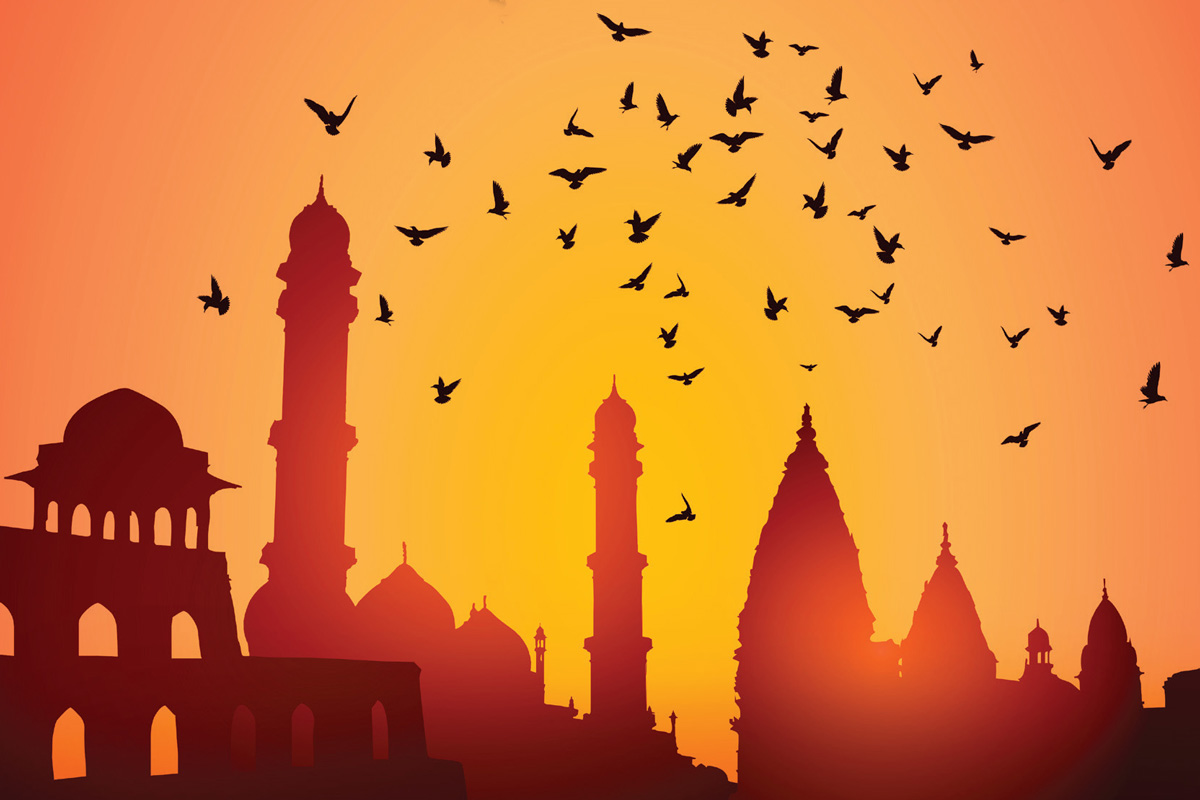
10 Mar What got us here
Polite Warning:You may find this section long… but if you read through it, it will really, really give you a professor’s understanding of Delhi’s rich history and its many layers. Read it in bits and pieces if you like…
Delhi’s Eight Cities
Why was Delhi such a magnet for rulers?
As invaders swept through the Khyber Pass in to India and made their way through the rich, fertile plains of Punjab towards the South East, they had to seize and hold Delhi.
“To seize it that he might be able to march forward. To hold it lest he should find his road barred on the way back. To do this he had to be the strongest man of his day. Therefore he who held Delhi, held India.”*
In the beginning, the Rajputs…
Lal Kot was built by the Rajputs, who ruled Delhi and its surrounding areas for a long 400 years, before the coming of the Turkic Slave dynasty. The ruling Rajputs were the Tomars, and they created their base at Surajkund, south of Delhi. Some of what they built still stands, like the impressive semicircular water reservoir and the remnants of Anangpur dam.
In 1060, Anangpal, the Tomar chief, constructed Lal Kot as a fortified citadel, and shifted his base here. Over time, the Tomars were displaced by another Rajput clan, the Chauhans. Though the Chauhans, including the dashing Prithviraj Chauhan, ruled out of Ajmer, they continued to occupy Lal Kot. They renamed it Qila Rai Pithora and enlarged its size and importance.
Some sections of the qila’s massive stone walls can still be seen in Mehrauli and Saket, but the rest of the city got subsumed in to what became the bustling urban center of Mehrauli.
The Remarkable Slave Dynasty (1206-90)
Qutubuddin was Ghori’s slave (hence the name “slave dynasty”). He had been sold in to slavery as a child in Turkestan and in the employ of his master, had risen up the ranks to be commander of his forces. He now set about consolidating Delhi, and when his master Ghori died in 1206, he declared himself the Sultan of Delhi.
Qutubuddin’s ascension as Sultan of Delhi, and with it the creation of the Slave Dynasty, was a momentous event in India’s history. It signaled the beginning of Muslim rule in India, which continued for the next six hundred years, through the Delhi Sultanate and then the Mughals, until it was replaced by the British in 1857.
Qutubuddin himself did not last long. He died within four years from injuries while playing his favorite game of polo in Lahore. He was succeeded by another Turkic slave–general, Iltutmish.
It was actually Iltutmish who decisively established the Slave Dynasty in India. He ruled for a long twenty five years, pushed the kingdom’s borders as far as Bihar in the east and provided a sound administration that survived long after him. The silver tankha (predecessor to the rupee), which became the basic coin throughout the Sultanate period, was introduced by him. The iqtadari system was also started, whereby nobles were given land in lieu of a salary, an administration philosophy that lasted many years in India.
Iltutmish was also way ahead of his time in terms of nominating his daughter Razia Sultan to be the ruler after him. He saw her as far more competent than her brothers and had no hesitation in recommending her for the throne. Though Razia did rule after her father, it was a short-lived reign sabotaged by jealous nobles who could not bring themselves to accept her.
After Razia, the only other ruler of note within the Slave Dynasty was Balban. A wily and politically astute man, Balban was already sixty-six years old when he started his reign, and he ruled until his death at the age of eight-seven. Balban was so iron-fisted and ruthless, killing anyone he regarded as a rival, that there was nobody capable enough to succeed him upon his death. This spelled the end of the Slave Dynasty.
The Slave Dynasty kings ruled from Mehrauli, Delhi’s first city, and some are buried there. Iltutmish’s tomb is close to the mighty Qutub Minar, which he completed during his reign. Balban’s half-collapsed tomb is also close by, within what is now the Mehrauli Archeological Park.
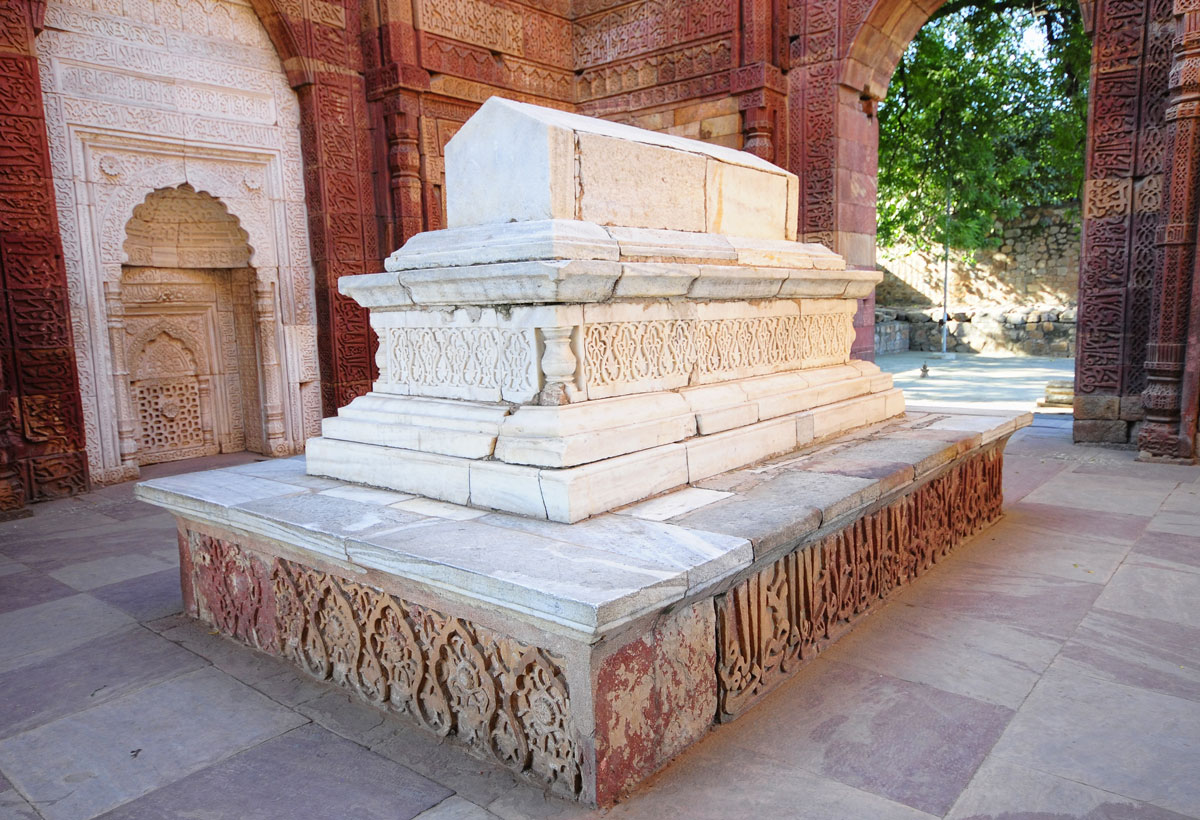 Iltutmish’s Tomb in Mehrauli; his competent twenty-five year reign fully established the slave dynasty
Iltutmish’s Tomb in Mehrauli; his competent twenty-five year reign fully established the slave dynasty The Imperial Power of the Delhi Sultans (1290-1526)
The Delhi Sultanate is actually a term coined by historians to describe the succession of Turkic and Afghan dynasties that ruled Delhi and much of north India in the 13th and 14th centuries for over two hundred years until the arrival of the Mughals.
The Slave Dynasty was succeeded by the Khaljis and then the Tughlaqs, Sayyids and Lodis. Together, they profoundly affected Delhi’s culture and society, influencing the whole of North India and beyond till the Deccan.
The main man for the Khalji’s was Alauddin Khalji. Alauddin ascended the throne by murdering his uncle, Jalaluddin, which was not in itself an unusual occurrence for the times. As many as nineteen of the Sultanate’s thirty-five kings were murdered; so, being a Delhi Sultan was clearly a risky business.
Once on the throne, Alauddin proved unstoppable, with military conquests in Gujarat, Chittor, Ranthambhor and up to Warangal in the South. He was the first Delhi ruler to fully tame the ferocious Mongols, chasing them all the way back to Central Asia, and ensuring that they did not dare invade Delhi again for as long as he ruled.
Alauddin built Delhi’s second city, Siri. We can still see parts of Siri fort in New Delhi, and the lovely Hauz Khas water reservoir that he built to provide water for his capital city. According to some, Siri Fort got its name from the thousands of severed Mongol heads (or sirs in hindi) embedded in its walls.
The story goes that there was a colony of thirty thousand Mongols living in Delhi, captured soldiers from previous raids, and that they were all put to death by Alauddin. Their heads are supposed to be gruesomely buried forever within the thick walls of his fort.
The Khaljis were followed by the Tughlaqs. They proved to be keen builders, with a distinctive architectural style of their own, and within the ninety year span of their dynasty, the Tughlaqs built Delhi’s third, fourth and fifth cities. They also built many of Delhi’s most enduring monuments, like the enigmatic Khirkee Masjid in Saket, the brooding Tughlaqabad Fort and the charming Hauz Khas madrassa with Feroz Shah Tughlaq’s tomb built around a lake.
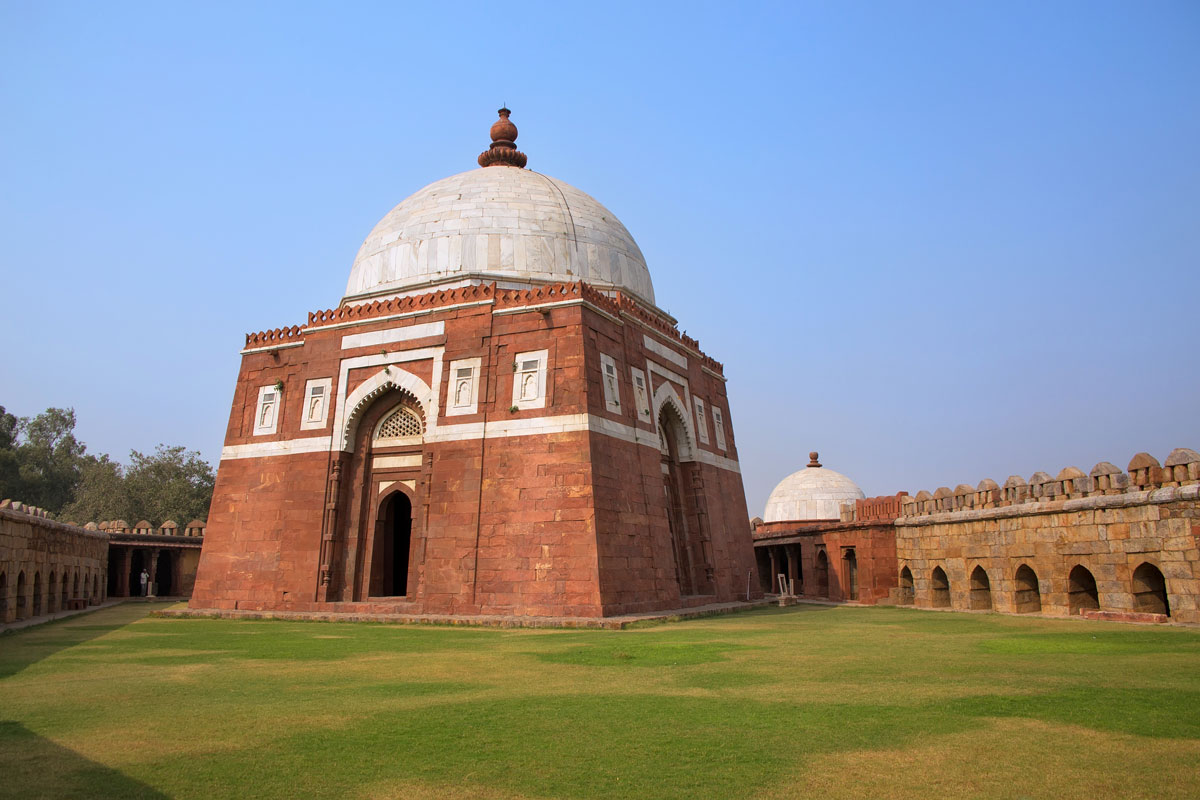 Ghiasuddin Tughlaq’s citadel-like mausoleum is in Tughlaqabad Fort, and is a typical example of solid Tughlaq architecture
Ghiasuddin Tughlaq’s citadel-like mausoleum is in Tughlaqabad Fort, and is a typical example of solid Tughlaq architectureThe Tughlaq style of architecture is very easily recognizable. These are solid constructions, massive and heavy, yet perfectly proportioned. During Tughlaq rule, Delhi was under the constant threat of Mongol raids, and so, their buildings reflect this reality. Even the Tughlaq mosques and tombs look like mini forts, constructed in a manner that allowed locals to shelter within them in case of Mongol raids. The aim was not to look pretty. There were no floral touches, pretty carvings or inlay work. But, they were certainly long lived.
The Tughlaq’s had three main kings. Ghiasuddin Tughlaq, the founder of the dynasty, lasted just long enough to build Delhi’s third city, the still imposing Tughlaqbad Fort. Ghiasuddin is said to have been murdered by his older son, Muhammad bin Tughlaq, who cleverly conspired to have a tent collapse on his father. He is buried in in a strikingly handsome citadel-like tomb within his majestic Tughlaqabad Fort.
Muhammad bin Tughlaq built his own capital called Jahanpanah, Delhi’s fourth city. Not much of Jahanpanah (meaning refuge of the world in Persian) remains today, apart from a few structures like the charismatic and sprawling Begumpuri mosque, said to be Delhi’s second largest mosque after Shah Jahan’s Jama Masjid. Another typical Tuqhlaq era construction, the solid looking Bijay Mandal, is located in what is today’s modern colony of Sarvapriya Vihar.
The third and last of the big Tughlaq kings was Feroz Shah Tughlaq, who built Delhi’s fifth city, Feroz Shah Kotla. He outdid all who came before him in restoration and construction work. He repaired the top two floors of the Qutub Minar that had been damaged by lightening in 1368, renovated the Hauz Khas and built his own tomb within the complex and carefully transported to Delhi two Ashoka pillars from other parts of India for use in his capital.
The Tughlaq’s were booted out after Feroz Shah’s death, their end hastened by the ferocious raid on Delhi by the Mongol ruler Timur the Lame in 1398, which more or less destroyed the Sultanate’s power and prestige forever.
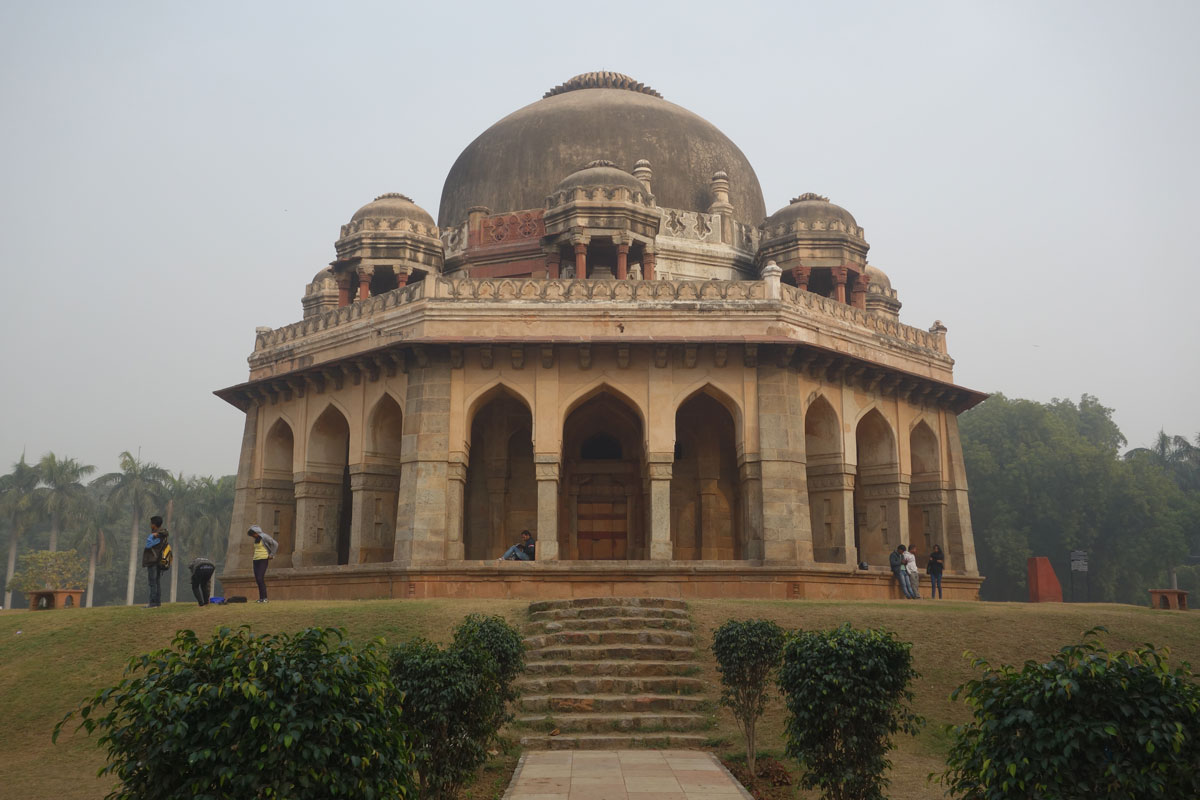 An excellent illustration of the mingling of Hindu and Islamic designs : Muhammad Shah Sayyid’s tomb in Lodi Gardens
An excellent illustration of the mingling of Hindu and Islamic designs : Muhammad Shah Sayyid’s tomb in Lodi GardensEventually, fed up with the weak Lodi rulers, Delhi’s powerful Afghan nobles invited Babur, ruler of Kabul and a descendant of both Timur and Chengiz Khan, to invade Delhi. Babur obliged in 1526, and so began the era of Mughal rule.
Delhi develops its unique society and composite culture
A new architectural style was created with the merging of Hindu and Islamic designs. Muslim rulers brought with them the use of arches and domes, and these were blended with Hindu-style square pillars, ornamental chattris and overhanging chajjas, borrowed from the architecture of Rajasthan and Gujarat. Perhaps, what best symbolizes this beautiful mingling of styles is the fact that nearly always, the final decorative flourish on the tops of these Islamic domes is a lotus, the most timeless of all Hindu symbols.
The royal Afghan tombs in Lodi Gardens are excellent examples of all these elements. In the mausoleums of Mubarak Shah Sayyid and Sikander Lodi, you can see it all; soaring domes topped with lotuses, Islamic inscriptions on the walls, ornamental chattris supported by Hindu-style pillars and Rajasthani carved brackets or chajjas.
Meanwhile, in the bazaars and streets of Delhi, new languages were now heard. Persian and Arabic began to be used locally, along with Hindvi, an older form of Hindi. New regional dialects like Khari Boli and Braj Bhasa developed. This mix of languages was best personified in the famous poet Amir Khusro who lived and flourished during this time.
Sufism spread as a philosophy. Its inclusive pull was being adopted by an ever- wider part of the population. Many of the most renowned Sufi saints were based in Delhi and had their kanqahs here. The first of them was Bakhtiyar Kaki in Mehrauli, who was so instrumental in spreading Sufism to Delhi and whose wonderful, calming shrine is from where the annual Phool Waalon Ki Sair procession is started each year.
He was followed by his famous disciple Nizamuddin Auliya and then Chirag Dilli, both of whose dargahs are still widely visited today. Delhi became such a hot spot for Sufi shrines that the city was called Hazrat Delhi as a mark of respect.
The Sufi shrines were also great crucibles for the development of music. Qawwali, the original Sufi devotional music, was established as a new musical genre, pioneered by the genius of Amir Khusro with the blending of Persian, Turkish and Indian musical traditions. What Khusro started all those centuries ago is still wildly popular today, resonating as much with today’s youth as it did many generations ago.
Delhi became increasingly prosperous. Agriculture improved dramatically with new canal constructions and irrigation methods, including what came to be known as the Persian wheel. And, the city was a magnet for consumption. Caravans of traders would visit with goods from around the world to cater to the free-spending habits of the rich aristocracy, and these would be duplicated in mushrooming karkhanas, with trades like metalwork, stonework and textiles propelling the economy.
The city developed its own distinctive, inclusive, merged culture. Of course, there were also moments of cruelty and fanaticism, both religious and ethnic, as part of the overall power grab by vicious rulers. But, seen within the context of the medieval times in which it was set, Delhi’s society grew and matured as remarkably tolerant and pluralistic.
The Outstanding Mughals (1526-1857)
The Mughals were lucky to have a succession of kings of unusual talent and ability. They were together truly outstanding, and they made Delhi and India famous on the world stage. Historians generally place the Mughals with Turkey’s Ottomans and England’s Tudors as the greatest of the medieval dynasties. It is not for nothing that the word mogul in English translates to power, wealth and prestige.
But, the early years for the Mughals were very shaky. Babur himself lasted only four years after his victory at Panipat, dying in Agra at the young age of forty-seven. It was left to his son Humayun to consolidate the empire, which was not easy in the face of fierce resistance by the Afghan ruler from Bihar, Sher Shah.
Sher Shah bested Humayun in a series of exchanges. The Mughal scion was forced to flee to Persia, where he remained in exile over the next several years, given refuge and shelter by the Persian king. While Humayun had started building his own version of a capital city in Delhi, this was completed by Sher Shah as Dinpanah, Delhi’s sixth city, known today as Purana Qila.
It was only after the death of Sher Shah, in 1555, that Humayun could return to Delhi and re-take the city. Unfortunately, he did not enjoy his return to India for long. Hurrying to attend a call to prayer, he fell down the stairs in his library in Purana Qila and died, prompting the remark that the luckless Humayun stumbled out of life the same way he had stumbled through it.
Though Humayun had mixed success as a king, it was more than compensated for in the sheer grandeur of his final resting place. He is buried in the iconic Humayun’s Tomb, said to be a precursor to the Taj Mahal and one of the most visited tourist monuments in Delhi.
The next three Mughal Kings – Akbar, Jehangir and Shah Jahan – had between them a combined reign of more than a hundred years of prosperity, high culture and arts, military might and magnificent architecture.
Akbar was the greatest of them all. Becoming king at the young age of fourteen with the sudden death of his father, Akbar ruled for forty-nine years. His genius lay in co-opting the independent minded Rajputs and making them equal stakeholders in the empire’s machinery. And, with the stability that this provided, Akbar created the political, administrative and military structures to effectively govern an empire that was the size of most of modern India.
Akbar was the first Mughal king who was born in India, who was entirely local in his sentiments, who married a Rajput Hindu and who instinctively understood the need for collaboration in political and social order. Amazingly, he was illiterate and could neither read nor write. This made him a strong ear to the ground type of ruler, distrustful of topline reports from nobles and a frequent visitor in disguise to the various overflowing bazaars in his cities, eager to hear and see the goings-on for himself.
Unfortunately for Delhi, both Akbar and his son Jehangir chose to rule their empires out of Agra, which explains the relative lack of imposing Mughal monuments from their reigns in Delhi. It was Shah Jahan, Jehangir’s son, who shifted the capital back from Agra to Delhi.
Shah Jahan had an insatiable appetite for building, and his reign marked the cultural zenith of Mughals’ rule. Shahjahanabad (today’s Old Delhi) is Delhi’s seventh city, complete with its magnificent Red Fort, Jama Masjid and Chandni Chowk. Political power flowed back from Agra to Delhi, and Shahjahanabad became a global nerve center for urban culture and commerce.
What goes up must come down : the terminal decline of the Mughals
Aurangzeb was the last of the big Mughal kings. He ruled for a long fifty years (1658-1707), and it was during this period that the Mughal Empire began its terminal decline. An austere and humorless man, Aurangzeb’s military ambitions used up a large part of the state’s resources, keeping him away from Delhi for long periods of time. And, his social policies undid the cohesive culture of the Mughals before him, alienating the majority of his subjects who were Hindu, which affected the unity of his empire.
True to the nature of his rule, Aurungzeb died outside of Delhi near Aurangabad, at the advanced age of eighty-eight. Covetous powers from Central Asia once again took advantage of the chaos and instability following his death.
The Persian king, Nadir Shah, invaded Delhi. On one horrific day – March 22, 1739 – his Persian troops pillaged the city, killing thirty thousand Delhi residents and heaping humiliation on the ineffective Mughal ruler of the time, Muhammad Shah Rangila. When Nadir Shah left, he took the magnificent Peacock Throne and the famed Koh-i-Noor diamond with him.
Mughal strength would never recover. New powers like the Marathas were asserting their might, and rival cities like Hyderabad and Lucknow began emerging as alternate seats of power.
Enter the European Traders and the East India Company
The sea merchants from Europe, lured to India by the rich trade in spices and cloth, were establishing their presence on India’s coast. The initial settlers were Portuguese, but they were soon joined by the Dutch and English. These European rivals fought among themselves for control of the sea-lanes along India’s west coast and set up a string of small forts from Bombay to Goa to Kerala.
The natural barrier of the imposing Western Ghats, strung like a citadel down India’s west coast, ensured that these Europeans remained confined to the thin sliver of land down the coast and equally ensured that the Mughals and other land-based kingdoms remained inland and did not much disturb their maritime trade. “Wars by sea are merchants affairs” “and of no concern to the prestige of Kings” **
Among the European powers, the British were the most successful. Slowly, they began to establish a land empire, starting with Madras, then Bombay and then Calcutta. Through the late 1700s, the British East India Company kept gaining control of parts of the sub-continent.
Set up in London as a commercial entity for trading in Indian spices and textiles, the East India Company’s commercial success led to its rise as a political power. In 1803, they went to war with the Marathas just east of Delhi, and victorious, they then marched on Delhi. The Mughal Emperor was placed under British “protection”, and an administrator, called the British Resident at the Mughal court was installed to take over the running of the city. The Company began fully controlling Delhi’s power politics.
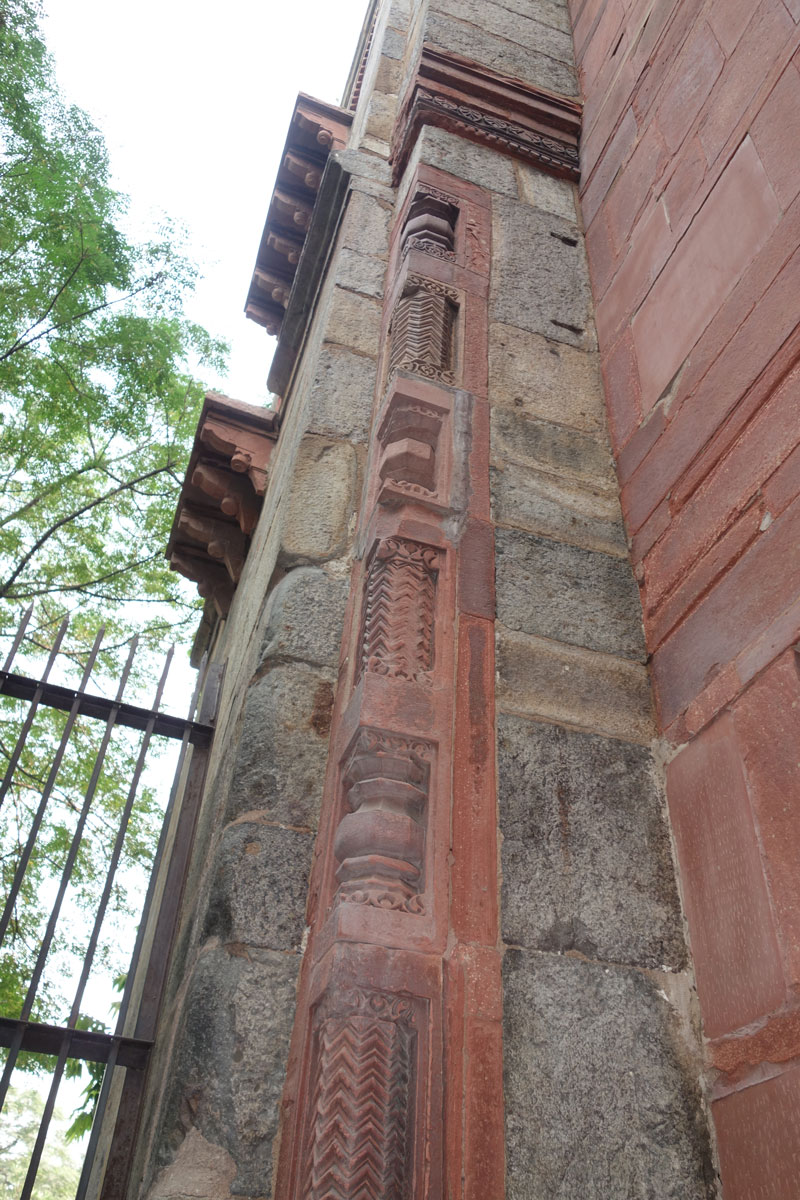 The imposing pillars of Khooni Darwaza : where the last of the Mughal Princes were shot and their bodies left to hang.
The imposing pillars of Khooni Darwaza : where the last of the Mughal Princes were shot and their bodies left to hang.The Mughals Last Hurrah and the Sepoy Mutiny (1857)
The Mughal Emperor Bahadur Shah Zafar was on the throne, a poet himself and a great lover of art. Under his patronage, Delhi was a city of poets. Ghalib, Zauq, Daag Dehelvi and Momin Khan Momin were all famous contemporary poets, competing with each other in nightly mushairas.
Delhi’s society was one of courtly manners, refined tastes and high living. And, adding to this exotic mix were Englishmen, Scotsman and Europeans, many of them famous and celebrated residents who were pulled to Delhi as traders, mercenaries, bank managers and soldiers. These were the original “white Mughals”, enthusiastically adopting local traditions and becoming one with Delhi’s culture.
Unknowingly, this heady cultural scene soon took on dark overtones. Social unrest was bubbling away under the surface. The British became more and more distant from the locals. And, the locals – both Hindus and Muslims – were getting increasingly angered by perceived British insensitivity towards their traditions. Things came to a head with the Sepoy Uprising, or First War of Independence, that broke out in Meerut on May 10, 1857, and engulfed Delhi the next day, catching the British totally unawares.
On May 11, 1857, the rebelling sepoys marched into Delhi from Meerut and declared Bahadur Shah Zafar their leader. Scores of British residents were murdered, and those who survived fled to the ridge, north of Delhi, and took refuge there. The fighting in and around Delhi lasted four months until September 1857.
When the British wrested back control of the city, they were thirsting for revenge, and their response was heavy-handed. Delhi was completely gutted. The glittering Shahajanabad was left in ruins and the Red Fort sacked and looted. The last of the Mughal emperors, the aged Bahadur Shah Zafar, was escorted out of Delhi and banished to far-away Rangoon. His sons and heirs were shot dead, their bodies left to hang in what is now Delhi’s Khooni Darwaza, signaling the end of the famed Mughals.
The British Raj and the Jewel in the Crown (1857-1947)
After the 1857 revolt, the East India Company was wound up, and the British Crown directly took control of India. Queen Victoria was now the Empress of India, and the colony would be governed by a Viceroy, based not in Delhi but Calcutta, which was made the new capital of British India.
This arrangement did not last for long. Calcutta’s status of British capital proved short-lived, as Delhi’s inherent dynamism and strategic location again tilted political power in its favor. In 1911, at the coronation of King George V, it was announced that Delhi would replace Calcutta as the capital of India.
Work was immediately started on creating the grand new capital, New Delhi, Delhi’s eighth city. Designed by the British architect Edward Lutyens as an imperial capital to rival Washington and Paris, New Delhi took twenty years to conceive and build and was officially inaugurated in 1931.
For New Delhi, Lutyens forged a new architecture style, blending British with Mughal and Buddhist influences and the liberal use of local red sandstone. Along a central axis (Kingsway, now Rajpath), an imposing Viceroy’s Palace was built on one end (today’s Rashtrapati Bhawan) and a poignant war memorial at the other end (India Gate), modeled on London’s famous Cenotaph, which was also built by Lutyens. To this day, Lutyen’s Delhi continues to retain its slightly distant air of distinguished government offices, impressive boulevards and tree- lined streets.
No doubt, the majesty and grandeur of New Delhi was expected to reflect the supremacy of colonial rule. But, the British seemed to have badly misjudged their longevity in India. With the end of the Second World War, a weakened Britain, faced with a determined Indian freedom movement, decided to call it quits and left India in 1947.
The Tryst with Destiny – Independence, Partition, and After
In its long history, Delhi has had its share of cataclysmic events, and the partition of 1947 was another. It changed the face of Delhi. A big part of Delhi’s Muslim population migrated to Pakistan, replaced by immigrant Hindus and Sikhs who arrived as refugees. Whereas earlier, Delhi had clustered around Old Delhi (Shahjahanabad) and New Delhi, the new arrivals camped instead on the city’s periphery and laid the foundations for the modern metropolis of today.
Over the last seventy years, Delhi has prospered as the capital of Independent India. It remains the central pole around which the events of India revolve, just as it has since medieval times. The city’s population has swelled, attracting countless newcomers eager to get a slice of the pie. At the same time, the infrastructure has struggled to keep pace, and in some cases, attitudes too have struggled to adapt.
Fellow Indians, particularly those from other cities, sometimes view today’s Delhi as a bit of a superficial place, with a reputation of being aggressive, ambitious, prosperous but also insensitive and self obsessed, lacking the cultural vibrancy and social etiquette that had made it famous in the past. Perhaps, this is one of the city’s biggest challenges going forward.
But, Delhi retains its amazing historic architecture, sprinkled like stardust across the city, almost an embarrassment of riches largely unexplored. These give substance to Delhi’s storied past and connects us with the ageless, timeless Delhi, as a reminder of what this city is all about.
In the lovely words of Thomas Metcalfe, the East India Company’s British Resident to the Mughal Court, “These ruins of grandeur…intended to convey to futurity the deathless fame of its cold inhabitant… now passed by unknown and unnoticed. These things cannot be looked at with indifference.”
* Finnermore, John. Quoted by Laura Sykes, in Percival Spear’s Delhi : its Monuments and History, Third edition
** Wilson, Jon. India Conquered. Page 24.
Doffing our hats to the ASI
* Finnermore, John. Quoted by Laura Sykes, in Percival Spear’s Delhi : Its Monuments and History, Third edition
** Wilson, Jon. India Conquered. Page 24.
Fourth Time Lucky
The first such brutal sacking was in December 1398 by the ferocious Mongol ruler, Timur the Lame (or Tamerlane).
Feroz Shah Tughlaq’s death ten years earlier – in 1388 – had created a power vacuum in Delhi. The Sultanate was ruled by weak successors, forever squabbling. Mahmud Tughlaq was on the throne, a weak inheritor of a once- mighty empire. Timur saw this and took his chance, sweeping across with his battle-hardened Mongols from Central Asia and hitting Delhi like a hurricane.
For most of his life, Timur was occupied with the swirling conflicts of Central Asia, in which he had been involved since his youth. In one of these battles, Timur was struck on his waist by an arrow, which made him lame. Thus, the Persian nickname Timur-e-Lang or Timur the lame. This handicap did not stop him though, as Timur went on to create an empire stretching from China to the Mediterranean, with Samarkand as his capital.
Unbelievable as it may sound, out of all the vast booty that Timur pillaged in Delhi, he was most struck by a pair of white parrots presented to him by a Delhi noble. Timur writes that the birds “could talk well and pleasantly…the sight of these parrots and the sound of their voices gave me great satisfaction, so I gave directions that they should be bought before me in their cages every day so that I might listen to their talk…I looked upon the two parrots as the best of their gifts”.
Delhi recovered, and over the next three hundred years – with the advent of the Mughals – developed beyond compare. The Mughals made Delhi one of the most sophisticated urban centers of the world. Shah Jahan developed Shahjahanabad and embellished it with jewels like the Red Fort, Jama Masjid and Chandni Chowk. But, all good things must come to an end, and with the decline of Mughal power, Central Asian rulers again started looking at Delhi with greedy eyes.
Nadir Shah was furious when he heard this. On the morning of March 22, 1739, he mounted his horse and rode from the palace to Sunheri Masjid in the middle of Chandni Chowk (then called the Roshan-ud-daulah Masjid). Climbing the stairs to the roof of the mosque, standing by Sunheri Masjid’s golden domes, Nader Shah drew his sword and held it high, ordering his troops to begin a savage qatl-i-aam or general massacre of Delhi’s population.
During this siege, life was traumatic for the people of Delhi. Law and order had completely broken down. Sanitation in the city fell apart, business had came to a standstill and prices were rising fast. To make matters worse, the local tribes living in Delhi’s surrounding countryside took full advantage of the lawlessness, robbing any one moving goods into or out of the city.
So, Delhi has seen the highest of the highs and the lowest of the lows and has survived both. The ageless city marches on.
* Eraly, Abraham. The Age of Wrath. A History of the Delhi Sultanate. India : Penguin Books 2014. Pages 190-202 (Timur)
** Wilson, Jon. India Conquered. Simon & Schuster 2016.
Summary
-
Delhi’s Eight Cities
-
In the beginning, the Rajputs…
-
The Remarkable Slave Dynasty (1206-90)
-
The Imperial Power of the Delhi Sultans (1290-1526)
-
Delhi develops its unique society and composite culture
-
The Outstanding Mughals (1526-1857)
-
What goes up must come down : the terminal decline of the Mughals
-
Enter the European Traders and the East India Company
-
The Mughals Last Hurrah and the Sepoy Mutiny (1857)
-
The British Raj and the Jewel in the Crown (1857-1947)
-
The Tryst with Destiny – Independence, Partition, and After

